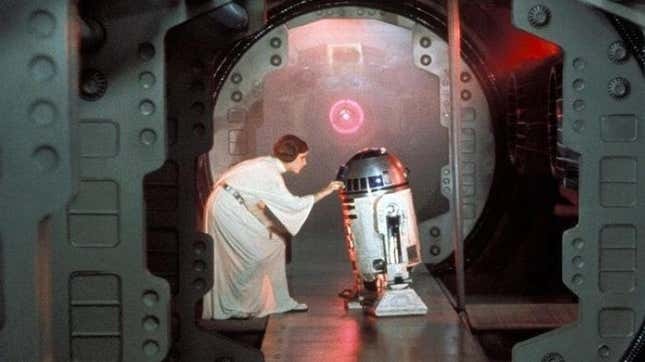
Image: Lucasfilm
In current Star Wars canon, the plot to steal the Death Star’s technical plans is incredibly straight forward: it’s Rogue One: A Star Wars Story, the tale of Galen Erso’s sacrifice and the ragtag team that swooped down to Scarif and gave their lives to ensure that data fell into Rebel hands. But in the expanded universe, one of Star Wars’ most legendary games set the stage for a much larger, more complicated process.
Dark Forces, released in 1995—and re-released this week with a new remaster across PC and consoles—was one of the first slices of Star Wars gaming, alongside the flight sim X-Wing a couple years prior, to let gamers live out an incredible dream: as Kyle Katarn, be the hero to swipe the Death Star plans from under the Empire’s nose, and set the stage for the events to come in A New Hope. The problem is, in the years since, “steal the Death Star plans!” became just as buzzy a video game fantasy as “play the battle of Hoth!” or “become a Jedi!”—and as the Expanded Universe kept, well, expanding, version after version of the plot to steal the Death Star plans kept getting told, and needed to all interconnect in some logical way.
The result was Operation Skyhook: after learning of the existence of the Death Star while it was still under construction, Alliance leadership tasked a series of raids and intelligence operations designed to acquire information, and ultimately liberate technical data, relating to the battlestation’s superstructure, and any indicators of weakness that could be exploited. Playing out across over a decade of video games, comics, and books—and of course culminating in the events of A New Hope—Skyhook was the scattered story of how the Alliance won its first key victory against the Galactic Empire.
The Secret History of the Ultimate Weapon

Image: Lucasfilm
The Death Star didn’t hatch entirely from the mind of Palpatine; a planet-sized superweapon had been theorized for years even before the the climax of the Clone War and the establishment of the Galactic Empire gave the now-Emperor the means and desire to construct such a weapon. Early ideas for a planetary battle station were developed by Raith Sienar, a scion of Santhe/Sienar Technologies. After discovering Sienar’s design plans for an “Expeditionary Battle Planetoid,” Wilhulff Tarkin—a Republic military official and close confidant of now-Chancellor Palpatine in the wake of Valorum’s ousting—presented the plans to the Chancellor, who, in his dual identity as Palpatine and Sidious, began quietly enacting plans to iterate on the design and set the stage for its eventual construction.
It was Palpatine’s separatist allies in the Geonosians who would ultimately refine Sienar’s plans into a feasible superweapon, with their battle plans secured by Count Dooku on Geonosis during the outbreak of the Clone War, who returned the plans to his master on Coruscant. As the Clone Wars came to an end three years later—and the Republic gave way to Palpatine’s Empire—the plans for the Death Star were brought out of Palpatine’s personal veil of secrecy and enacted as one of the first great works of the new regime. Constructed in shadow, the need to avoid potential insurgent activity from discovering the weapon prior to its completion, the plans were split up into various files and distributed across Imperial research stations and facilities across the galaxy, in the hopes that a single breach would uncover Palpatine’s plans.
Capture and Discovery

Image: Lucasfilm Games
The
Death
Star
was
constructed
over
the
course
of
the
next
few
decades
and
kept
under
wraps—until
a
moment
of
hubris
set
the
stage
for
Operation
Skyhook
to
begin.
The
signing
of
the
Corellian
Treaty
in
2BBY
officially,
formally
established
the
Alliance
to
Restore
the
Republic
underneath
Senators
Mon
Mothma,
Bail
Organa,
and
Garm
Bel
Iblis,
themselves
leaders
of
multiple
resistance
groups
working
against
the
the
Empire.
Through the deception of Palpatine and his apprentice, Darth Vader, the meeting was interrupted by Vader, and the captured senators—alongside the rebellious former dark acolyte trained by Vader, Galen Marek—were brought to see the still-under-construction Death Star in all its glory before their execution. Marek, turning to the light side, sacrificed himself to buy the senators time to escape the facility, and in his memory the newly formed Rebellion established its first major operation in open war with the Empire: find the technical plans of the Death Star and analyze them for a weakness so that it could be destroyed.
First Covered In: Star Wars: The Force Unleashed (2008)
Phase 1: Raid on Corulag
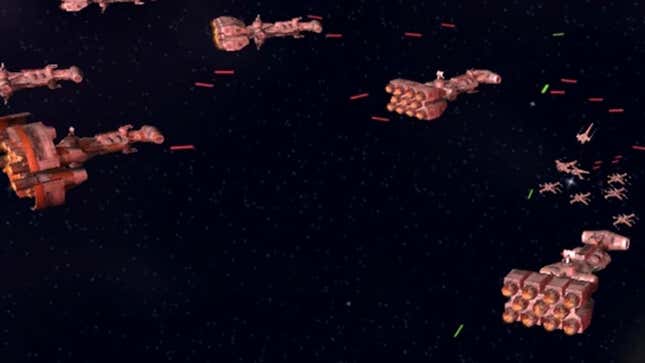
Image: Lucasfilm Games
After
Captain
Raymus
Antilles,
acting
on
Bail
Organa’s
behalf,
recruited
the
smuggler
Han
Solo
to
plant
tracking
devices
and
EMPs
on
a
ship
bound
to
an
Imperial
research
facility
in
orbit
over
the
planet
Corulag,
a
Rebel
raid
recovered
data
to
“confirm”
the
existence
of
the
battle
station
Alliance
Command
had
been
captured
on,
as
well
as
the
scope
of
its
destructive
capability.
Also
recovered
during
the
raid
was
the
personal
slave
of
now-Grand
Moff
Tarkin,
recruited
to
the
Rebel
cause:
a
young
Mon
Calamari
named
Gial
Ackbar.
First Covered In: Star Wars: Empire at War (2006)
Phase 2: Death Star Rebellion

Image: Lucasfilm Games
Meanwhile, during construction aboard the Death Star itself, prisoners staged a violent uprising against Imperial forces stationed there. In the chaos of the rioting, the first technical data about the Death Star recovered was beamed to a Rebel cell operating on the planetoid Polis Massa—before Vader’s personal Stormtrooper legion, the 501st, quelled the riots. Formerly stationed aboard the battle station, Vader put the 501st to work hunting down the now-missing plans.
First Covered In: Star Wars Battlefront II (2005)
Phase 3: Transfer to the Tantive IV

Image: Lucasfilm Games
Rebel
listening
outposts
stationed
in
the
Cron
Drift
recovered
further
technical
data
about
the
Death
Star,
leading
to
Rebel
operative
Biggs
Darklighter
personally
escorting
the
information
from
there
to
the
Mon
Calamari
cruiser
Independence,
which
then
transferred
the
data
to
Organa’s
personal
ship,
the
corvette
Tantive
IV.
Defended
by
the
X-Wings
of
Red
Squadron
and
several
blockade
runners
acting
as
decoys,
the
transfer
was
completed
and
the
Tantive
IV
fled
to
a
base
on
the
planet
Toprawa.
First Covered In: Star Wars: X-Wing (1993)
Phase 4: Dark Forces Rising

Image: Lucasfilm Games
The
combination
of
the
data
from
Polis
Massa
and
the
data stolen
in
the
Cron
Drift
laid
the
foundations
for
the
bulk
of
the
Rebel
Alliance’s
knowledge
of
the
Death
Star’s
layout,
but
a
vital
piece
of
the
puzzle
remained
missing:
layouts
of
the
station’s
point
defense
systems.
After
tracking
down
a
potential
set
of
schematics
to
the
planet
Danuta,
Mon
Mothma
hired
the
mercenaries
Kyle
Katarn
and
Rianna
Saren
to
recover
the
plans
held
there.
Both
successfully
completed
their
missions
and
beamed
the
data
to
the
Rebel
operatives
on
Toprawa.
First Covered In: Star Wars: Dark Forces (1995), Star Wars: Lethal Alliance (2006)
Phase 5: The Battle of Toprawa
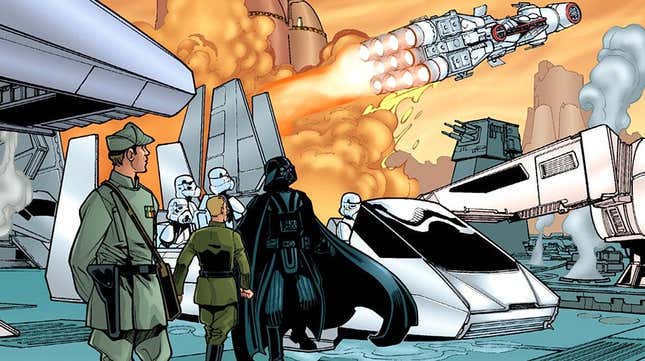
Image: Dark Horse Comics
The Rebel spies based on Toprawa, now in possession of almost all of the Rebellion’s knowledge of the Death Star, launched a raid on Imperial research facilities there to recover the final pieces of technical data required—including potential weaknesses in the superstructure’s design. The raid and subsequent capture of the data lead to finally combining the gathered information into a complete technical schematic of the Death Star held by Leia Organa aboard the Tantive IV which escaped the blockade enacted on the world in response to the Rebel attack.
In the Expanded Universe continuity, it was this, not the Battle of Scarif, that was the “first victory” mentioned in A New Hope’s opening crawl.
First Covered In: Jedi Dawn (1993)
Phase 6: The Last Stand of Polis Massa
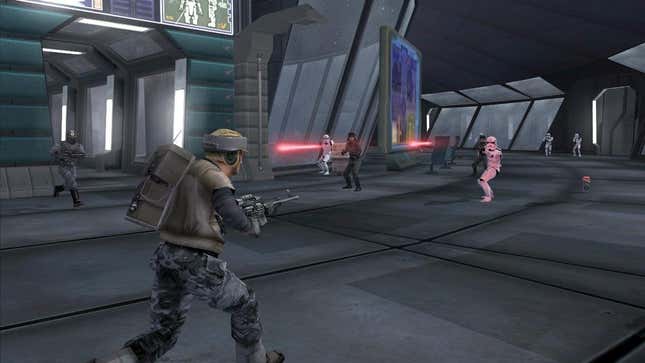
Image: Lucasfilm Games
Concurrently, the 501st finally tracked the initial leak of Death Star data stolen during the prisoner uprising on the station to Polis Massa, where they encountered and eliminated a Rebel cell—but not before discovering the signal from the cell’s transmission of the data to the Tantive IV, tracking the stolen plans to the ship.
First Covered In: Star Wars Battlefront II (2005)
Phase 7: Siege of the Tantive IV
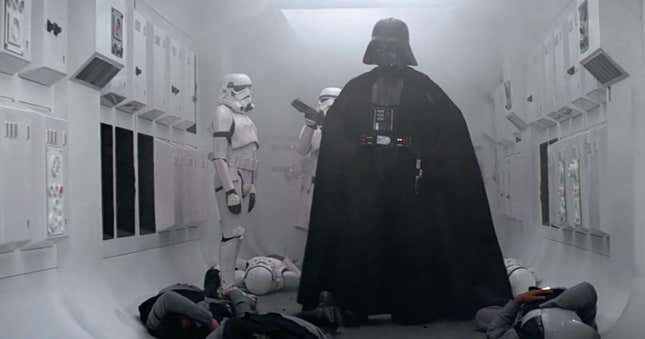
Image: Lucasfilm
Eager to save face after the embarrassment the 501st faced during the prison uprising, Vader took his forces in pursuit of the ship, which attempted to resist capture under Leia Organa’s senatorial immunity before succumbing to an Imperial boarding action. With the majority of the crew killed during combat or captured by Vader’s forces in the aftermath, Senator Organa was rendered into Imperial custody—but the stolen plans were nowhere to be found in the Tantive IV’s databanks. Little did the Empire know that an escape pod containing two droids was hurtling down to the nearby desert world of Tatooine with the data in one of their memory banks, and... well, you know the rest of it from here, don’t you?
First Covered In: Star Wars: A New Hope (1977)
Many Bothans Died, Anyway
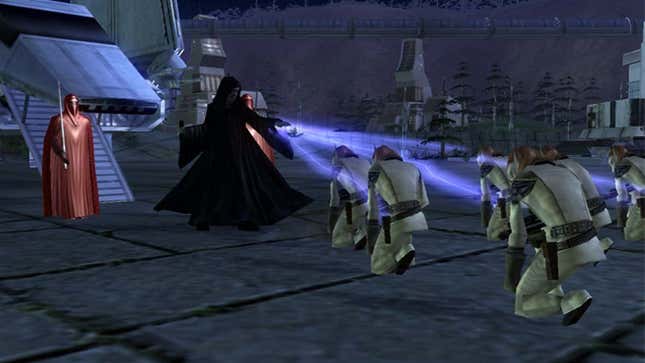
Image: Lucasfilm Games
Mon
Mothma’s
utterance
of
the
phase
“Many
Bothans
died
to
bring
you
this
information”
in
Return
of
the
Jedi
was
in
reference
to
the
technical
readouts
of
the
second
Death
Star
in
construction
above
Endor,
not
the
first
iteration
of
the
battle
station.
That
small
detail,
however,
did
not
stop
the
EU
from
slaughtering
a
bunch
of
Bothans
for
the
first
time
round
anyway.
Sometime before the Polis Massa cell recovered the technical data stolen during the Death Star uprising, a defecting Imperial Moff, Kalast, worked with the Bothan Spynet to crack a series of Imperial command codes related to the Death Star’s systems and transmit them to the alliance. A furious Palpatine traveled to the Bothan homeworld, Bothawui, to punish its people for the Spynet’s complicity, personally slaughtering untold numbers of Bothans alongside his personal guard. A surviving Bothan begged for their life by revealing the Tantive IV as the location of the stolen codes and plans were being sent to, leading to Vader’s chase.
First Covered In: Star Wars: Empire at War (2006)